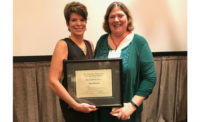Sailing into the wind isn’t easy. However, by learning how to tack, literally a series of zig-zag maneuvers to maximize the force of the wind as it pushes against the sails, one can move forward — even quite rapidly under skilled hands.
Mike Koch has been sailing the confectionery seas for the past 43 years. In fact, he’s been doing so on the same boat: Morley Candy Co. He’s done everything, from swabbing the deck to fixing the motor, from navigating through rough waters to capturing America’s Cup — or more accurately, Candy Industry’s 71st Kettle Award.
As Koch, who started his confectionery career in 1973 sweeping floors as a high school student working part-time, explains, “The very idea of being nominated for the Kettle Award was something I never expected.”
Of course, this is coming from a man who’s been inducted into the Candy Hall of Fame and received the President’s Award from Retail Confectioners International.
“It was an honor to be nominated,” he continues. “The past Kettle recipients include great people from the industry. I never thought, even in my wildest dreams, to be considered for such an honor.”
In reflecting on the moment when his name was read, Koch shared that he was hopeful, but really didn’t expect to be selected.
But then the captain of operations at Morley Candy Co. probably didn’t expect to be with the same company throughout his career. It’s been a fascinating journey, beginning when he decided that he wanted to be a candy maker and then enrolling in RCI’s Gus Pulakos International Candy School, which resulted in Koch taking over as the company’s head candy maker.
Since then he has served the company in many different capacities, including maintenance supervisor, quality control director, warehouse manager, director of R&D, and now as v.p. of manufacturing.
Anyone walking through with Koch in the company’s 72,000-sq.-ft. facility receives a detailed education about the processes, the machines and the company’s history. The man has literally installed, fixed and maintained almost every single piece of equipment in the plant.
“Back when I started with the company, we were located in a 10,000-sq.-ft. building, one that was added on to several times,” he says. “When we moved into the new building in 1990, the space seemed enormous. We were using about 25,000 sq. ft. of space for manufacturing. Never did I think we would fill it.”
But fill it the company did — and then some. Today, Morley’s operates five lines, with production occupying about 45,000 sq. ft. To accommodate operations, the company ships finished goods to an offsite 48,000-sq.-ft. warehouse.
And all signs point to continued growth.
Koch says the roots of that growth began when Morley’s purchased the Sanders brand in 2002. As he points out, Sanders Chocolates was known to nearly every Michigan resident — or “Michiganders” as they call themselves.Founded by Fred Sanders on June 17, 1875, the company eventually grew to 57 retail shops throughout the Great Lakes Region. The shops sold candy, fudge toppings and baked goods as well as light lunches and an assortment of fountain counter specialties, including ice cream sodas, sundaes and hot fudge cream puffs.
The company soon became the leading purveyor of confections in the region and started selling directly to national supermarket chains, as well as to other retailers in the area. Although it only has nine retail shops, the Sanders brand can still be found in a broad range of retail outlets, from supermarket chains and mass merchandisers to mom-and-pop outlets as well as convenience stores.
Morley’s, on the other hand, was heavy into fundraising. The owners at the time, however, saw that segment of the business — as it applies to confectionery — declining.
“If the company wanted to survive, it had to do something,” Koch explains.
Acquiring Sanders proved to be a godsend, providing Morley’s with a historic brand that had a high quality reputation — one in keeping with Morley’s own tradition. It created access to retail accounts and a new wholesaling business as well as provided the company with nine retail shops. And there was also an unexpected benefit: ex-Michiganders.
As Karen Jefferson, v.p. of sales and marketing explains, “Michigan was the only state to lose population as recorded by the last U.S. Census in 2010. Fortunately for us, Sanders is a really strong Michigan brand.”
Initially, it was the snowbirds in states like Florida and Arizona that were clamoring for Sanders’ line of caramels, chocolates, topping and cakes. In time, these “brand ambassadors” made their feelings known to local retailers, which in turn started stocking Sanders’ products.
Strong demand also began to originate in non-retirement states, such as Texas, New York and California, which opened up “more opportunities with national retailers,” adds Jefferson.
Within this period, the Morley family decided to capitalize its assets to fund growth, calling in a group of investors. The investors, which “wanted to see us succeed,” adds Koch, eventually determined it was time for them to recoup their monies and move on. They offered to sell the company to the management group. In 2008, Koch became a co-owner along with Brian Jefferson, ceo; Ron Rapson, president; and Karen Jefferson, v.p. of sales & marketing.
It was during this same time frame that Koch started the company on the road toward ISO and SQF certification, which are industry standards for world-class food manufacturing companies. In June of 2015 Morley Candy became SQF Level 3 certified — the highest level possible.
The certification process dovetailed with a revamp of the company’s marketing program and Sanders’ product packaging.
“We went about changing the packaging and energizing marketing,” says Brian. “We also increased our research and development efforts. If you’re not trying out new ideas, you will fail as a company. Go to any food show, and the first thing out of the buyers’ mouths is ‘What’s new?’ That’s always been the case, but today it’s more intense than ever.”
The rebranding efforts proved successful, to the point that the company needed to increase its capacity. Koch nods, adding that the company embarked on a five-year program involving “major equipment expansion.”
“It was clear that we needed more cooking capacity, which meant new cooking equipment,” he says. Of course, the first step was to install a new boiler, which could provide the additional steam necessary. New 600-gallon, steam-jacketed cookers followed. Shortly thereafter, a new 34-in. enrobing line was installed.
Each investment, however, was made with the intent of maintaining the Morley/Sanders quality credo, which goes back to Fred Sanders: "…bring European confectionery style to America by using only the finest ingredients and providing dutiful customer attention, while selling confections at a reasonable price."
For example, take caramel production. Today, there are many operations that use a continuous cooking method to produce caramel, says Koch.
“We’ve tested the process and it didn’t produce the same flavor profile we were looking for,” he says. “So we continue to do a batch process. Since we produce a cream-based caramel, controlled scorching of the cream is critical. We only use fresh cream, a combination of half-and-half, whipping cream, evaporated milk, and sweet condensed milk. Thus, when we bring it to a boil, we get that caramel color and flavor we’re looking for.”
All in all, Morley’s produces 25 varieties of caramel, which is the company’s No. 1 product. In that category, dark chocolate salted caramels lead the charge. The item has been a game changer for Morley’s.
It’s one of the reasons the company installed a new Imperial Design 180-ft. enrobing line two years ago. And it’s also one of the reasons the company has another Imperial Design line being installed currently. Both can turn out 640 pieces of dark chocolate sea salt caramels per minute.
The company also installed a new lidder to facilitate packaging of the caramels into tubs for a major club store customer. In total, Morley’s has spent $5 million during the past five years on equipment, allowing it to meet sales growth — double-digit during that same time frame — as well as maintain labor levels.
Within that modernization effort, the company also purchased a new ERP system dubbed Plex that connects to every production line in the plant. In addition to tracking production numbers and ingredient costs, the system can enable a recall test in 10 minutes, detailing the origin and batch number of every ingredient involved in making a specific product.
“Three years ago, we worked 13 Sundays out of the year,” Koch says. “Last year, we only worked one Sunday. People need a life aside from work and automation allows that.”
It also allows a company to react to a changing retail landscape as well as consumer preferences for convenience and choice, such as the introduction of standup pouches, which Koch calls “one of the most drastic changes in confectionery during the past few years.
“The 1-lb. box of assorted chocolates and candies is dying,” he says. “People used to open a box containing 32 pieces and feel each piece to see what they wanted. Today, consumers want their specific favorites in a pouch or tub. National retailers also want different looks on their shelves.”
To that end, the company has launched a line of Mini-Bites, bite-sized versions of its favorites (Peanut Butter Caramel, Milk Chocolate Caramel and Dark Chocolate Sea Salt Caramel) as well as convenience- and portion control-oriented 3-Piece Caramels (available in Milk Chocolate Sea Salt Caramel, Dark Chocolate Sea Salt Caramel and Milk Chocolate Espresso with Dark Drizzle varieties). A new Bosch flow wrapper, capable of handling 400 packs a minute, was purchased to address that need.
But it doesn’t end there. As Brian points out, consumers are looking for cleaner labels, and for better-for-you products. Within that context, however, taste remains paramount. Thus, the R&D effort, which Brian heads, remains constant.
“Sometimes Brian delivers more ideas than we can handle,” Koch says. “But we all know that to prosper, one has to change. Being stagnant doesn’t work; people don’t want the same old things.”
Currently, the company is looking at the possibility of producing organic products. That, however, doesn’t prevent it from adhering to an all-natural philosophy regarding ingredients. Nor does its commitment to automation preclude it from making specialty candies the “old-fashioned way.”
As Koch points out, he’s not aware of anyone making “honeycomb chips” the way Morley’s does. The taffy-like candy that’s coated in milk chocolate requires two experienced candy makers to produce. First, the 25-lb. batch is hand-spun to aerate the mass. After folding and cutting seven times — creating 128 layers and scores of nano “tubes” — the batch is compressed and cut into one-inch rectangles. An examination of the product prior to enrobing reveals a “honeycomb” of air pockets in the candy.
“It’s what makes it crisp but slightly softer than hard candy,” explains Koch.
Although the company makes it only twice a month because of the labor involved, it’s still part of the offerings that Michiganders remember and require. It also opens the door to customers and consumers looking for creativity and innovation in confections, even if it dates back more than 100 years.
That tradition makes the future look bright for Koch and the company. He expects Morley to hit double-digit sales gains again in 2017, a combination of increased sales with existing accounts as well as a broader scope of new customers.
In that light, Koch would like to add a new peanut cluster line as well as a new automated topping and filling unit. Space, however, is an issue, both for production and warehousing. The company is currently looking for a new temperature-controlled warehouse space approaching 100,000 sq. ft. And, if sales dictate, the current location could be expanded by another 35,000 sq. ft.
And that’s what makes this period of working in the confectionery industry so delightful for Koch. Kettle Award aside, he says that being in the position of overseeing expansion in manufacturing, and watching the company grow, makes the sailing truly sweet.
At-a-Glance: Morley’s Candy Co.
Headquarters: Clinton Township, Mich.
Sales: $30 million (Candy Industry estimate)
Employees: 200
Products: Caramel, chocolate-enrobed confections, nut clusters, dessert toppings, nuts, fruit and snack dips, toffee, mints and popcorn.
Retail shops: 9
Brand: Sanders
Sales Breakout: Retail shops – 22 percent; Sanders wholesale – 60 percent; private label – 15 percent; mail-order/internet – 3 percent.
Management team: Brian Jefferson, ceo; Ron Rapson, president; Karen Jefferson, v.p. sales & marketing; Mike Koch, v.p. of operations.





























